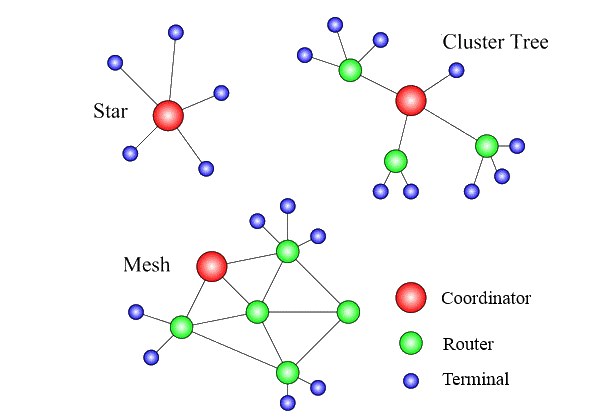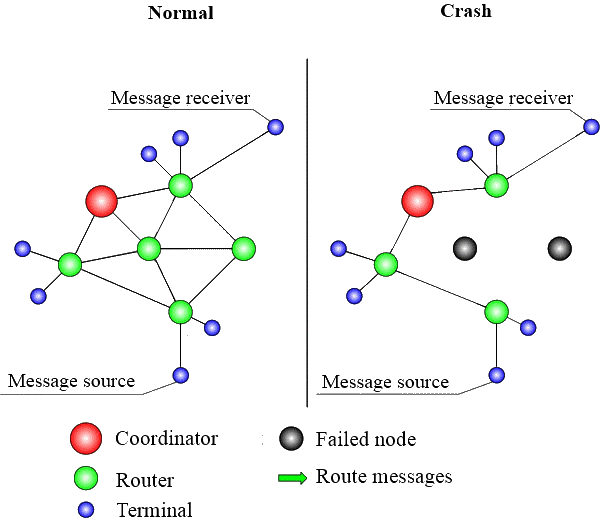Abstract
Content
Introduction
In the modern world it's no surprise the wireless transmission of data. In our lives long ago penetrated mobile technology and the Internet, a global positioning system and radio frequency. However, only a relatively new wireless technologies have been applied in the areas of public utilities and industry. The effectiveness of the implementation of such systems in the industry is very high, as it is here, there are a lot of automation objects of varying complexity, the relationship between which is convenient to carry through wireless channels. And in the case of the location of the system on a moving object, as it can be automated warehouses, the use of wireless networks is the only possible solution. Until recently, the introduction of these technologies in the industry was held back due to problems associated with the reliability of communications in harsh environments with high levels of industrial noise, as well as to the protection of industrial wireless networks from unauthorized access. Now the situation has changed, and the field of "exotic" wireless industrial networks move to appropriate technical solutions. This fact can not be ignored, and the manufacturers of actuators, in particular, the complete electric, which should be designed taking into account the availability of built-in wireless interface.
1. Networking ZigBee
ZigBee Ц a relatively new wireless standard that was originally developed as a means for transferring small amounts of data over short distances with minimal power consumption. In fact, this standard describes the rules for the operation of hardware and software that implements wireless communication devices together.
ZigBee protocol stack is a hierarchical model, built on the principle of the seven-level model of data communication protocols in open systems OSI (Open System Interconnection).The stack includes levels standard IEEE 802.15.4, responsible for the implementation of the communication channel, and software network layers and levels of support for applications defined specification ZigBee [1]. The models of the ZigBee communication standard is presented in Figure 1.

Figure 1 Ц Multilevel model of the communication standard ZigBee
IEEE 802.15.4 standard defines two lower stack level: medium access layer (MAC) and physical layer data in the propagation medium (PHY), i.e. lower levels of wireless data transmission protocol [2]. Alliance defines ZigBee stack software layers of the data link layer (Data Link Control) to the level of device profiles (ZigBee Profiles). The reception and transmission of data over the air is the physical layer PHY, defines the working frequency range, modulation type, maximum speed, number of channels (Table 1 Itza). PHY layer performs the activation-deactivation of the transceiver, detecting the energy received signal in the working channel, the selection frequency of the physical channel, the communication quality indication upon receipt of a data packet and clear channel assessment. It is important to understand that the 802.15.4 standard Ц it is a physical radio (chip radio transceiver), and ZigBee Ц a logical network and software stack, providing security and routing functions.
Next, the structure of ZigBee stack should be the level of media access control IEEE 802.15.4 MAC, carrying in and out of the network devices, networking, data encapsulation, the implementation of various security modes (including 128-bit AES), 16 - and 64 - bit addressing.
The MAC layer provides various mechanisms for access to the network supporting network topologies from "point to point" to "multicell network" secure communication (ACK, CRC), and supports streaming packet data.
To prevent unwanted interactions can use a time division protocol based on CSMA-CA (multiple access protocol for communication with the control carrier and collision avoidance).
Time division ZigBee is based on the use of the synchronization mode in which the subordinate network devices, most of the time are in the "sleep" state, periodically "wake up" to receive the clock signal from the network coordinator, which allows devices within a local area network cell to know at what point in time to transfer data. 802.15.4 standard is based on half-duplex data transmission (the device can either transmit or receive data), which does not use the CSMA-CA for collision detection Ц only to prevent them.
The specification stack provides three types of devices: a coordinator, router and end device. The coordinator initializes the network, run by its nodes, stores information about the configuration of each node, sets the number of the frequency channel and network PAN ID, and in the process may be the source, receiver and relay messages. The router is responsible for the choice of the way to deliver a message sent over the network from one node to another, and in the process can be also a source, destination, or relay messages. If routers have appropriate opportunities, they can determine the optimized routes to a certain point and store them for later use in the routing tables. The terminal is not involved in the management of the network and relay, as the only source / receiver messages.

Figure 2 Ц The ZigBee Network Topologies

Figure 3 Ц Self-configurable network with complex topology (animation: 6 frames, 6 cycles of repeating, 130 kilobytes)
2. Data standard IEEE 802.15.4
ZigBee-stack specification defines the network level, the levels of security and access to the application and can be used with solutions based on 802.15.4 for device compatibility.
Table 1 Ц Specification Standard IEEE 802.15.4
Standard |
802.15.4 ZigBee Щ |
||
Rotatingspeed |
868 MHz |
915 MHz |
2.4GHz |
Numberof channels / step |
1 |
10/2 MHz |
16/5 MHz |
Geographicalspread of the |
Europe |
America |
Wholeworld |
Max. rate, modulation |
20 kbit / s, BPSK |
40 kbit / s, BPSK |
250 kbit / s, O-QPSK |
Outputpower, nom. |
0 dBm (1 mW) |
0 dBm (1 mW) |
0 dBm (1 mW) |
Range |
10-100m |
||
Sensitivity(specification) |
-92dBm |
-92dBm |
-85dBm |
The size of the stack |
4-32 KB |
||
BatteryLife |
From 100 to 1000 or more days |
||
The size of the network |
65536 (16-bit address), 2 64 (64-bit address) |
||
One of the main advantages of 802.15.4/ZigBee standard is the ease of installation and maintenance of such systems. Features of the ZigBee specification make it easy to deploy wireless personal area networks, "you simply pull the device out of the box, insert the batteries and make a simple operation such as pressing Ц hold the two devices together, press the button and hold for as long as the green lightї. Thus there is a combination of two devices in a network, or binding, for example, a light switch to a particular lamp. The implementation of this principle involves the introduction of ZigBee-modules to all new devices and systems for the home and office. As a result, it is possible to create a single network of compatible devices from various manufacturers.
The main criterion for the introduction of new technologies in large enterprises Ц the final price of a single device. Price issue in such applications is extremely high, and on an industrial scale, even tenths of a cent play a huge role. However, a major way to reduce cost of the final solutions ZigBee is the large number of existing and potential markets and increase the supply of electronic components from the manufacturers. Home appliances market is huge and billions of units [5].
Create a library of profiles of single devices in a network of ZigBee, designed to ensure interoperability of equipment from different manufacturers. User profiles (set of services necessary for the specific type of device, such as lighting or fire sensors) located at the top of the stack ZigBee, provide standard software modules for use in specific applications.
Conclusion
ZigBee operates at radio frequencies that do not require a license, and therefore use a ZigBee device can be anyone. However, this is not it a competitive advantage. The attractiveness of new items is ultrasmall power consumption micro-transmitters. Argued that built on a ZigBee-based irrigation system golf course will keep its operation for over 7 years without having to replace the batteries in the sensors. And it is in systems composed of multiple sensors that automatically combine into a network, the benefits of ZigBee will be most noticeable.
The secret efficiency is that the products based on the ZigBee transmit small amounts of data and operate at a rate of about 250 Kbit / s, i.e. are sufficiently slow devices. However, to obtain data from sensors such as "on / off" this is enough. Is more important than efficiency and simplicity of the device Ц that these benefits provide the demand for ZigBee for everyday use.
Another feature of the technology Ц easy to scale the network, operating on technology ZigBee. Without any modifications or additional adaptation based on the ZigBee network can be constructed from multiple sensors and created a gigantic system of many hundreds radio sensors. For the standard of applying for a mass-oriented and inexperienced users, the quality is truly unique.
Perhaps this is why analysts are predicting a great future as ZigBee industry standard for devices aimed at the consumer market. Unlike wired counterparts, the deployment of the network based on ZigBee is much more than a simple affair, and besides, also saves a lot of money. For example, the creation of the fire protection system of a large hotel typically require laying miles of cable, the installation of hundreds of sensors, organization management from a central console, and so on. When using ZigBee all boils down to the placement of radio sensors in the rooms, everything else Ц setting relationships and building a network Ц automatically. Well, almost automatically. Still, something will have to do and installers engaged in setting up the system. But that's of kilometers of wires can be omitted I'm sure.
This master's work is not completed yet. Final completion: December 2013. The full text of the work and materials on the topic can be obtained from the author or his head after this date.
References
- Wi-Fi alliance. [Ёлектронный ресурс]. Ц –ежим доступа: http://www.wi-fi.org/
- Bluetooth special interests group (SIG). [Ёлектронный ресурс]. Ц –ежим доступа: http://www.bluetooth.org
- ZigBee alliance. [Ёлектронный ресурс]. Ц –ежим доступа: http://www.zigbee.org
- IEEE Computer Society. Part 15.4: Wireless Medium Access Control (MAC) and Physical Layer (PHY) Specifications for Low-Rate Wireless Personal Area Networks (WPANs). IEEE Std 802.15.4Щ-2006. [Ёлектронный ресурс]. Ц –ежим доступа: http://standards.ieee.org/getieee802/802.15.html
- ZigBee Alliance. ZigBee Specification. Q4/2007. [Ёлектронный ресурс]. Ц –ежим доступа: http://www.zigbee.org/en/spec_download/zigbee_downloads.asp
- Ќезнамов ё., озаченко ¬.: ѕерспективы использовани€ беспроводных ZigBee-интерфейсов в электроприводе // Ёлектронные компоненты. 2008. N. 2. —. 17-24.
- ¬рем€ Їлектроники. [Ёлектронный ресурс]. Ц –ежим доступа: http://www.russianelectronics.ru/leader-r/review/40498/doc/44411/
- ≈ркин ј.: »дентификаци€ потоков грузов RFID-метками на основе беспроводных сетей ZigBee. Ѕеспроводные технологии є2'2011. [Ёлектронный ресурс]. Ц –ежим доступа: http://wireless-e.ru/articles/bluetooth/2011_02_34.php
- —околов ћ., ¬оробьев ќ.: –еализаци€ беспроводных сетей на основе технологии ZigBee стандарта 802.15.4. омпоненты и технологии є2'2005. [Ёлектронный ресурс]. Ц –ежим доступа: http://www.kit-e.ru/assets/files/pdf/2005_02_160.pdf
- утыев ».: ƒолгоиграющие устройства ZigBee. [Ёлектронный ресурс]. Ц –ежим доступа: http://www.uley-club.ru/index.html?tid=17435
